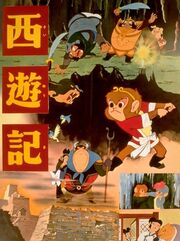{#if:Script error: The function "findpagetext" does not exist. |
|
}}
| Alakazam the Great | |
|---|---|
 Theatrical release poster | |
| Directed by | Taiji Yabushita Daisaku Shirakawa |
| Written by | Keinosuke Uekusa |
| Based on | Journey to the West by Wu Cheng'en Boku no Son Gokū by Osamu Tezuka |
| Produced by | Hiroshi Okawa |
| Starring | Kiyoshi Komiyama Noriko Shindō Hideo Kinoshita Setsuo Shinoda |
| Narrated by | Sterling Holloway |
| Cinematography | Harusato Otsuka Komei Ishikawa Kenji Sugiyama |
| Edited by | Shintaro Miyamoto Kanjiro Igusa |
| Music by | Ryoichi Hattori |
Production company | Toei Doga |
| Distributed by | Toei Company |
Release dates | <templatestyles src="Plainlist/styles.css"/>
|
Running time | 88 minutes |
| Country | Japan |
| Language | Japanese |
Alakazam the Great, known in Japan as Saiyūki (西遊記, lit. "Journey to the West"), is a 1960 Japanese anime musical film, based on the 16th-century Chinese novel Journey to the West. It was one of the earliest anime films to be released in the United States.[1] Osamu Tezuka was named as a director of the film by Toei Company. However, Tezuka later stated that the only time he was in the studio was to pose for publicity photos.[2] His involvement in promoting the film, however, led to his interest in animation.[3]
Plot[]
Alakazam is a young and brave monkey (a macaque) who has been encouraged by all the other monkeys to become their king. After attaining the throne, he becomes rude and dictatorial, and does not believe that human beings are greater than he is. Then he deceives/forces Merlin the magician to teach him magic (reluctantly on Merlin's part, who warns Alakazam that the powers he acquires now will bring him much unhappiness later).
Alakazam becomes so arrogant that he abuses his magic powers, and chooses to go up to Majutsu Land (the Heavens), to challenge King Amo. He is defeated by King Amo. For his punishment, he is sentenced to serve as the bodyguard of Prince Amat on a pilgrimage; in order to learn humility. Ultimately, he learns his lesson and becomes a true hero.
Characters[]
| Japanese name | Japanese voice actor | English name | English voice actor |
|---|---|---|---|
| Sun Wukong | Kiyoshi Komiyama | Alakazam | Peter Fernandez (speaking) Frankie Avalon (singing) |
| Lin-Lin | Noriko Shindō | DeeDee | Dodie Stevens |
| Zhu Bajie | Hideo Kinoshita | Sir Quigley Broken Bottom | Jonathan Winters |
| Sha Wujing | Setsuo Shinoda | Max Lulipopo | Arnold Stang |
| Tang Sanzang | Nobuaki Sekine | Prince Amat | |
| Shakyamuni | Kunihisa Takeda | King Amo | |
| Guanyin | Katsuko Ozaki | Queen Amas | |
| Shōryū | Michiko Shirasaka | Filo Fester | |
| Bull Demon King | Kinshiro Iwao | King Gruesome | |
| Princess Iron Fan | Tamae Kato | Queen Gruesome | |
| Golden Horned King | Kiyoshi Kawakubo | Herman McSnarles | |
| Silver Horned King | Shuichi Kazamatsuri | Vermin McSnarles | |
| Subhuti | Merlin | ||
| Taibai Jinxing | |||
| Erlang Shen | Hercules |
U.S. release[]
The film was released in the United States by American International on July 26, 1961. For the American release, a few scenes were heavily edited and rearranged and bandleader Les Baxter was hired to compose a new soundtrack. Teen idol Frankie Avalon supplied the singing voice of Alakazam (the speaking voice was done by Peter Fernandez), and Sterling Holloway provided English-language narration. Other famous voices included Jonathan Winters, Arnold Stang, Dodie Stevens, and E. G. Marshall.
Reception[]
Despite a large marketing budget and heavy promotion, the film was unsuccessful in America. The Los Angeles Times called it "warm, amusing and exciting... the art work is really excellent."[4] It was included as one of the choices in The Fifty Worst Films of All Time, and is the only animated film featured in the book.[5]
Home media[]
The AIP version of the film was first released on VHS in the 1980s by HBO/Cannon Video (under licensed from then-owner Orion Pictures). This release was reissued by Congress Video Group in 1990 at a slower speed. Orion Home Video re-released the film in both pan-and-scan and widescreen letterbox VHS editions and on a widescreen laserdisc in 1995. Although MGM hasn't released the film on DVD, the AIP version has been made available for streaming on Netflix and Amazon Prime Video.
Popular culture[]
The Mario video game franchise antagonist Bowser was inspired by the film. Nintendo designer Shigeru Miyamoto received inspiration for the character's appearance from the anime film. He had first envisioned Bowser as an ox, basing him on the Ox-King from the film.[6]
See also[]
- List of animated feature films
- List of Osamu Tezuka anime
- List of Osamu Tezuka manga
- Osamu Tezuka's Star System
References[]
- ↑ Lenburg, Jeff (1999). The Encyclopedia of Animated Cartoons. Checkmark Books. ISBN 0-8160-3831-7. https://archive.org/details/isbn_9780816038312/page/XXX/mode/2up. Retrieved 6 June 2020.
- ↑ Beck, Jerry (2005). The Animated Movie Guide. Chicago: Chicago Review Press. ISBN 1-55652-591-5. https://archive.org/details/animatedmoviegui0000beck.
- ↑ Patten, Fred (1996). "A Capsule History of Anime". Animation World Network. Retrieved 2014-12-04.<templatestyles src="Module:Citation/CS1/styles.css"></templatestyles>
- ↑ Warren, Geoffrey (23 September 1961). "'Alakazam' Delightful New Cartoon Movie". Los Angeles Times (Los Angeles, Calif.): p. A6.
- ↑ "The Fifty Worst Films of All Time".<templatestyles src="Module:Citation/CS1/styles.css"></templatestyles>
- ↑ David Oxford. "Iwata Asks:The Birth of Bowser". Ds.Kombo. Archived from the original on September 17, 2010. Retrieved August 23, 2010.<templatestyles src="Module:Citation/CS1/styles.css"></templatestyles>
External links[]
Template:Toei Animation films Template:Journey to the West Template:Osamu Tezuka
| This page uses Creative Commons Licensed content from Wikipedia (view authors). |